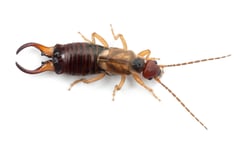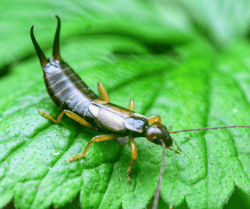Earwigs. Incredibly quick and with pinchers that look straight out of a horror movie, earwigs are not a welcome guest in most homes. With the added European myth that they enjoy crawling into our ears at night, it’s no surprise that homeowners jump at the sight of an earwig skittering across the floor. While earwigs are certainly a less-than-pleasant houseguest, the question remains: can earwigs actually cause damage to my home or property?

What are earwigs?
Earwigs are small, nocturnal insects that are typically omnivorous in nature and have a preference for moist environments. Earwigs make up the insect order Dermaptera, home to roughly 12,000 species. Earwigs are easily identified by their characteristic cerci, or pinchers, and two sets of wings – a membranous, folded wing beneath shorter forewings. They are typically dark brown or reddish brown in color with flat, elongated bodies and fast-moving legs.
Earwigs are native to Europe; however, they reportedly appeared on both coasts of the United States in the early 1900’s. They are now widespread and can be found on every continent with the exception of Antarctica, though they are most prevalent in the southern and southwestern regions of the States. Earwigs received their name from a common European myth that insisted earwigs would crawl into your ears at night and burrow into your brain. This myth is exactly that – a myth! There is no evidence that earwigs seek out human ears. In fact, earwigs largely avoid humans altogether.
Because earwigs are naturally omnivorous, they tend not to be picky about what they eat. Earwigs are happy to munch on a variety of plants, animals, and fungi such as grass, vegetables, flowers, fruit trees, berries, and moss. They are also known for eating garden-destroying aphids along with caterpillars and eggs from various insects. In some circumstances, earwigs may also act as scavengers, eating decaying greenery and dead insects. In an indoor environment, earwigs may turn to several different food sources, including dry goods, flour, dog food, houseplants, herbs, cloth goods, paper, and more.
.jpg?width=250&height=179&name=earwig-climbing-up-plant-2022-10-31-21-40-09-utc%20(1).jpg)
Why are there earwigs inside my home?
Earwigs can end up in your home for a multitude of reasons. Sometimes they catch a ride into your home entirely by accident, being brought in on firewood or even on our clothes. They may also be attracted to the bright lights your home exudes at night. Still, they may be in search of food and shelter if their natural environment has left them high and dry. But how and where do these quick little critters gain entry to your home?
Earwigs can enter your home through nearly any crack or crevice as their small size allows them to squeeze through practically any opening. It’s suspected that many earwigs gain entry through cracks in your home’s foundation or slithering through damaged siding. They can also slip under doors with insufficient door sweeps. Gaps, where utilities enter the home, can also provide earwigs a potential entry route. In truth, a home with any small crack, gap, or crevice in its exterior (whether they’re aware of it or not) may be susceptible to earwigs.
Some common entry points for earwigs may include:
- Gaps and cracks where utility pipes or wires connect to your home
- Holes in window or door screens
- Gaps in window or door frames
- Damaged or nonexistent weatherstripping
- Cracks in your home’s foundation or siding
- Exterior ventilation units
- Damaged or missing home siding
- Open doors or windows with missing or damaged screens
Because earwigs are attracted to moisture, an influx of many earwigs in your home may indicate a moisture problem. If you have encountered a sudden infestation of earwigs, we highly recommend you inspect your home for signs of water damage or leaks. We also encourage you to contact a trusted pest professional immediately for quick treatment.
![]() Sealing exterior vents can help prevent earwigs from entering your home.
Sealing exterior vents can help prevent earwigs from entering your home.
Are earwigs harmful to me or my home?
Earwigs are generally considered to be nuisance pests, meaning they don’t pose a significant threat to humans or our homes. While equipped with sizable pinchers, earwigs will not pinch a person unless provoked. This typically occurs if someone attempts to pick up or physically handle an earwig. An earwig pinch may hurt a little, but it is unlikely to break the skin or cause serious damage. Earwigs aren’t known to carry any diseases, so a pinch from an earwig is not a cause for concern (though it may be unpleasant!) In addition to pinching, earwigs can also release a particularly potent and foul smell when agitated. The scent has been likened to that of rotting flesh or even feces. Needless to say, disturbing an earwig or being perceived as a threat may come with some unpleasant repercussions – though not inherently dangerous.
Earwigs also don’t cause any direct damage to your home. Though not great housemates, earwigs won’t destroy your floors or walls, nor will they cause any structural damage. That said, earwigs can wreak havoc on certain crops and other plants. They will gladly chomp right through flowers, veggies, and fruit plants. They are known to chew away at corn silks and even burrow into soft peaches or apricots. Despite this, earwigs also happen to feed on several garden pests, including garden-destroying aphids. Some gardeners are perfectly happy to let a few earwigs roam their garden as their ability to eradicate other pests can outweigh the potential damage they may cause to plants. In this way, the occasional earwig can be a welcome sight in the garden, but a large population may be more trouble than it's worth.

How can I prevent earwigs in my home?
Though relatively harmless, earwigs do not belong in our homes. Not only are they a nuisance to have around, but they also don’t tend to thrive in an indoor environment. Luckily, prevention is often the easiest and cheapest approach to effective pest control. At EcoShield, we always encourage pest prevention over pest removal whenever possible. With this in mind, here are a few tips that may help prevent earwigs from appearing in your home:
- Ensure potential food sources are stored in airtight containers.
- Recycle or throw out unneeded paper goods such as newspapers, magazines, mail, or paper bags.
- As an extra precaution, seal important documents in plastic sleeves or containers.
- Store additional clothing, blankets, sheets, or other fabric items in well-sealed plastic storage containers.
- Use plastic storage containers instead of cardboard boxes or plastic bags.
- Use dehumidifiers in basements, crawl spaces, attics, and even poorly ventilated garages.
- Ensure your home ventilation systems are running efficiently and clean any associated filters.
- Seal cracks, gaps, or holes in your doors, windows, siding, and utilities.
- Make necessary repairs quickly upon discovering them.
- Employ the help of a trusted pest professional to provide routine maintenance and identify potential problem areas.
- Utilize professional pest prevention treatments around the exterior of your home.
 Cracks in your home's foundation are an easy way for earwigs to get in.
Cracks in your home's foundation are an easy way for earwigs to get in.
Can EcoShield treat an earwig infestation?
Yes!
With EcoShield’s Home Protection Plan, we not only remove the existing earwig infestation, but we also disrupt the lifecycle and address target locations in your home to prevent future infestations. This service protects you not only from earwigs but a multitude of other creepy crawlies that frequently enter homes. Better yet, if you sign up for the Home Protection Plan before any kind of pest infestation, you’ll be protected from the headache of ever having to deal with a full-blown earwig infestation in your home.
If you’re struggling with an earwig infestation or have encountered them in your home in the past, contact EcoShield today! Our expert pest technicians are standing by, ready to bring you pest-free living and an earwig-free home. Call us or fill out the form on this page for a free, no-obligation quote today!